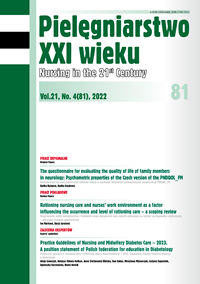Rationing nursing care and nurses’ work environment as a factor infl uencing the occurrence and level of rationing care – a scoping review
DOI:
https://doi.org/10.2478/pielxxiw-2022-0038Keywords:
rationed-uncompleted nursing care, nurses’ work environment, scoping reviewAbstract
RATIONING NURSING CARE AND NURSES’ WORK ENVIRONMENT AS A FACTOR INFLUENCING THE OCCURRENCE AND LEVEL OF RATIONING CARE – A SCOPING REVIEW
Aim. The aim is to describe and analyse the available studies describing the assigned nursing care and work environment of nurses. Design: Scoping review.
Methods. The search was conducted in four scientifi c databases Ovid Nursing, ProQuest, PubMed, and Scopus. Eleven studiem published between years 2000 and 2020 were included in the review.
Results. Eleven cross-sectional and correlational studies were analysed to document the prevalence of rationed nursing care in the acute hospital care setting. Studies evaluating rationed nursing care confi rm a strong relationship with the workplace nursingenvironment. Thus, the work environment is among the signifi cant determinants of rationed nursing care. The most commonly used tools include the PIRNCA tool for assessing hidden rationing of care and the PES-NWI tool for monitoring the work environment of nurses. When the work environment is rated as unfavourable, there is a higher rate of rationed nursing care.
Conclusions. Rationed nursing care is a phenomenon that is monitored globally, and its assessment is essential in health care delivery. The main reasons for the development of hidden rationing of care include inadequate staffi ng and facilities. Factors that contribute signifi cantly to the rationed nursing care are based on the work environment - mainly interpersonal relationships and communication, multidisciplinary collaboration
References
1. Kalisch BJ, Landstrom GL, Hinshaw AS. Missed nursing care: A concept analysis. Journal of Advanced Nursing. 2009; 65(7): 1509-1517. https://doi.org/10.1111/ j.1365-2648.2009.05027x.
2. Jones TL. A descriptive analysis of implicit rationing of nursing care: frequency and patterns in Texas. Nursing Economics. 2015; 33(3): 144-154. Available at: https://doi. org/1688632893/se-2?accountid=17239.
3. Lucero RJ, Lake ET, Aiken LH. Variations in nursing care quality across hospitals. Journal of Advanced Nursing. 2009; 65(11): 2299-2310. Available at: https://doi. org/10.1111/j.1356-2648.2009.05090.x.
4. Schubert M, Glass TR, Clarke SP, et al. Validation of the Basel extent of rationing of nursing care instrument. Nursing Research. 2007; 56(6): 416-424. Available at: https://doi.101097/01.NNR.0000299853.52429.62.
5. Bachnik S, Ausserhofer D, Baernholdt M, et al. Patient-centred care, nurse work environment and implicit rationing of nursing care in Swiss acute care hospitals: A cross-sectional multi-center study. International Journal of Nursing Studies. 2018; 81: 98-106. Available at: https://doi.org/10.1016/j.ijnurstu.2017.11.007.
6. Elbejanni M, Abed al Ahad M, Simon M, et al. Work environment-related factors and nurses´ health outcomes: a cross-sectional study in Lebanese hospitals. BMC Nursing. 2020; 19: 95. Available at: https://doi.org/10.1186/s12912-020-00485-z.
7. Zeleníková R, Jarošová D, Plevová I, et al. Nurses´ perceptions of Professional practice Environment ant Its Relation to Missed nursing Care and Nurse Satisfaction. Environmental Research and Public Health. 2020; 17: 3805. Available at: https://doi. org/10.3390/ijerph17113805.
8. Schubert M, Ausserhofer D, Desmndt M, et al. Levels and correlates of implicit rationing of nursing care in Swiss acute care hospitals – a cross sectional study. International Journal of Nursing Studies. 2013. 50(2), 230-239. Available at: https:// doi:10.106/j.injurstu.2012.09.016.
9. Papastavrou E, Andreou P, Tsangari H, et al. Rationing of nursing care within professional environment constraints: A correlation study. Clinical Nursing Research. 2014; 23(3): 314-335. Available at: https://doi.org/10.1177/1054773812469543.
10. Jones TL. Validation of the Perceived Implicit Rationing of Nursing Care (PIRNCA) Instrument. Nursing Forum. 2014; 49(2): 77-87. Available at: https://doi.org/10.1111/ nuf.12076.
11. Ausserhofer D, Zander B, Busse R, et al. RN4CAST consortium. Prevalence, patterns, and predictors of nursing care left undone in European hospitals: results from the multicountry cross-sectional RN4CAST study. BMJ Quality & Safety. 2014; 23(2): 126-135. Available at: https://doi:10.1136/bmjqs-2013-002318.
12. Duffy JR, Culp S, Padrutt T. Description and Factors Associated With Missed Nursing Care in an Acute Care Community Hospital. The Journal of Nursing Administration. 2018; 48(7-8): 361-367. Available at: https://doi.org/10.1097/ NNA.0000000000000630.
13. Zeleníkova R, Gurková E, Friganovic A, et al. Unfinished nursing care in four central European countries. Journal of Nursing Management. 2019; 28(8): 1888-1900. Available at: https://doi:10.1111/jonm.12896.
14. Dhaini SR, Zúñiga F, Ausserhofer D, et al. Are nursing home care workers’ health and presenteeism associated with implicit rationing of care? A cross-sectional multi-site study. Geriatric Nursing. 2017; 38(1): 33-38. Available at: https://doi.org./10.1016/j. gerinurse.2016.07.003.
15. Lake ET. Development of the Practice Environment Scale of the Nursing Work Index. Research in Nursing & Health. 2002; 25: 176-188. Available at: https://doi. org/10.1002/nur.10032.
16. Blizzard L, Woods SL. The Relationships Between the Implicit Rationing of Nursing Care and Emotionally Intelligent Leadership Style. The Journal of Nursing Administration. 2020; 50(12): 623-628. Available at: https://doi.org10.1097/ NNA.0000000000000949.
17. Peters MDJ, Godfrey CM, Khalil H, et al. Guidance for conducting systematic scoping reviews. International Journal of Evidence-Based Healthcare. 2015; 13(3): 141-146. Available at: https://doi.org/10.1097/XEB.0000000000000050.
18. Tricco AC, Lillie E, Zarin W, et al. A scoping review on the conduct and reporting of scoping reviews. BMC Medical Research Methodology. 2016; 16(15). Available at: https://doi.org/10.1186/s12874-016-0116-4.
19. Bacasksiz FE, Alan H, Eskici GT, et al. A cross-sectional study of the determinants of missed nursing care in the private sector: hospital/unit/staff characteristics, professional quality of life and work alienation. Journal Nursing Management. 2020; 28: 1975-1985. Available at: https://doi.org/10.1111/jonm.12999.
20. 20. Cho SH, Lee JY, You SJ, et al. Nurse staffing, nurse’s prioritization, missed care, quality of nursing care and nurse outcomes. International Journal of Nursing Practice. 2019; 26: e12803. Available at: https://doi.org/10.1111/ijn.12803.
21. 21. Kim KJ, Yoo MS, Seo EJ, et al. Exploring the Influence of Nursing Work Environment and Patient Safety Culture on Missed Nursing care in Korea. Asian Nursing Research. 2018; 12: 121-126. Available at: https://doi.org/10.1016/j.anr.2018.04.003.
Downloads
Published
Issue
Section
License
Copyright (c) 2022 Authors

This work is licensed under a Creative Commons Attribution 4.0 International License.




